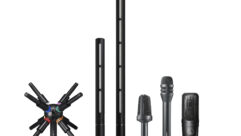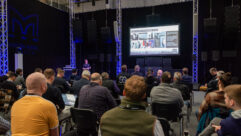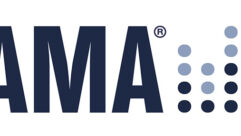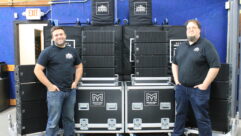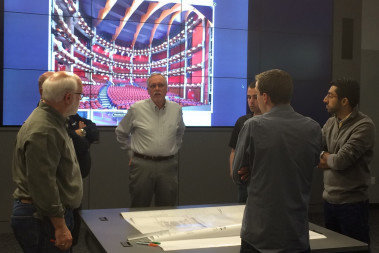
David Davies finds out what’s changed about the Audio Coverage Uniformity Standard – from a task group member and the organisation’s director of standards.
It is often said of certain areas of endeavour that they constitute an ‘inexact science’, but that is the last thing that can ever be said about the creation and refinement of professional technology standards. In fact, they require a level of exactitude that is pretty much unsurpassed, as the standards team at InfoComm would surely confirm.
An ANSI Accredited Standards Developer (ASC), the organisation has published seven standards over the last eight years. But the very first, in 2009, was Audio Coverage Uniformity (ACU) in Enclosed Listener Areas, and it is to this standard that InfoComm has recently returned for an important revision, ANSI/INFOCOMM A102.01:2017.
“As our first standards revision project it was a significant undertaking and, of course, we learned a great deal during the process,” recalls Thom Mullins, CTS, who is moderator for the standard task group and senior consultant for Affiliated Engineers Inc. “The first version was geared towards smaller enclosed spaces, such as theatres and concert venues, with a seating capacity of up to 5,000. It did achieve some traction, but we expect this second version to resonate more as it has a broader reach.”
Some of the key differences will be explained below, but it is important to note that many of the original standard’s key principles still apply. In essence, ACU focuses on the uniformity of coverage of a sound system’s early-arriving energy over a listener area. An ideal sound system should allow listeners to hear reproduced content at approximately the same sound pressure level independent of the listener’s position in a designated area. Therefore, ACU provides procedures by which to measure and classify the uniformity of coverage.
‘Most listener areas’
While the original ACU standard was designed for audio coverage in enclosed environments, the 2017 version expands the remit to accommodate most listener areas. It also takes advantage of improved measurement platforms to yield a more thorough understanding of system performance.
As a result of the changes, says InfoComm director of standards Ann Brigida, CTS, CST-D, “there will be greater consistency in results and reporting, and reduced time in the field taking measurements.”
Indeed, Mullins is at pains to stress that the modified version should greatly reduce the efforts needed to accurately quantify the performance of a room or system. “Reflecting on the first version, it was clear that there were too many measurement points required, which made it difficult in some cases for the consultant or contractor in terms of time taken,” he says. “So with this new edition one of the first things we did was to focus on minimising the number of measurement points, and as a result only four or five could be required to characterise a distributed overhead loudspeaker system with consistent loudspeaker spacing. More complex or non-standard systems would likely require additional measurement points, but still less than the original standard called for.”
There has also been a significant rethink of the original standard’s pass/fail mechanism because “we thought that the language around these aspects did not accurately describe from a performance standpoint what was actually going on in the venue. We wanted to get away from that so we worked on providing a number of operational ‘coverage envelopes’,” says Brigida.
Mullins adds that the final specified “envelopes are 3dB, 6dB, 8dB, 12dB, and ‘12dB or greater’. So for example, if you take measurements across all the octaves and find that the maximum and minimum in an octave band, or in all octave bands, are within 3dB then it is qualified to be a 3dB system – and you can write that up accordingly.”
The across-the-board implementation of “current measurement techniques” was among the other changes to the original standard that Mullins believes make the new version much easier to adopt. “There has been overall emphasis on the end-user and the outcome,” he notes, “and so we wanted to make the standard as straightforward to implement as possible.”
Forthcoming standards
The new version of the standard is available at the InfoComm website. It’s free for members and will be available for purchase by non-members. In addition, InfoComm will publish a design guide and field guide to help professionals as they seek to implement the standard.
But while the new version of the standard is clearly a significant step forward for InfoComm, several other initiatives are in progress that will seek to fill in some of the other key areas related to audio performance.
“We have been extremely busy over the last five years,” says Brigida, “and are currently in the final stages of working on a spectral balance standard. In essence, that will define three categories of systems that are taking care of the spectral balance frequency response. But we are also working on a number of further standards to cover other areas, including audio dynamic range – addressing nominal sound pressure and maximum sound pressure levels, and so on – as well as speech reinforcement and intelligibility.”
These efforts are expected to come to fruition over the next few years. In the meantime, there was an opportunity to find out more about all of the current initiatives at this year’s InfoComm, where standards representatives also participated in a roundtable discussion and other presentations. “We have also already done webinars about what has changed in the standard,” adds Mullins.
Only time will tell, of course, quite how widely the standard comes to be adopted, but when standards are ‘done right’, they can have universal appeal and impact. There is every reason to think that InfoComm will be at the forefront of the movement for improved audio performance in venues.



